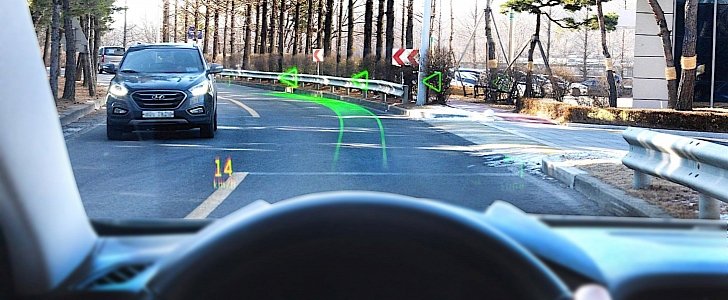Back in September last year, a group of companies that includes Porsche, Hyundai, and Alibaba announced they’re investing in a Swiss start-up by the name of WayRay as a means to develop augmented reality (AR) head-up display for use in cars.
Unlike traditional HUDs, which display images and info using an LCD screen mounted inside the car, WayRay’s AR projects the said images directly onto the road, at a distance of 15 m (50 feet) from the drivers’ eyes and adjusted to fit right into their viewing angle. The virtual image generated by the AR is 1,310 mm x 3,152 mm in size.
This allows the drivers to be kept up to date with whatever info is displayed without having to take their eyes off the road.
The AR works by gathering the information it needs by using inertial sensors, GPS sensors, and full HD cameras. These are used to continuously map the environment while keeping track of the car’s whereabouts in relation to the surroundings. Any information relayed back to the driver appears as part of the environment.
At the Consumer Electronics Show in Las Vegas, Hyundai decided to show the world the first application of the technology in a real-life car, a Genesis G80.
In this demo car, the AR system is used to project navigation alerts, lane guidance, destination points, and current speed. ADAS features, such as lane departure and forward collision warnings are incorporated into the system.
Hyundai says it’s extremely serious about making the tech commonplace in some of its cars and pledges to look into ways to incorporate even more features into the AR.
In the not so distant future, the AR will be able to display identification markers for people, objects, buses, bicycle lanes, and crosswalks. Even more ADAS systems like rear side warning system and the Highway Driving Assist (HDA) are also to be included.
In the medium term, the rise of vehicle-to-everything (V2X) technologies will also contribute to the expansion of the AR experience by incorporating traffic signals, surrounding vehicle information, road or weather conditions, all in real time.
This allows the drivers to be kept up to date with whatever info is displayed without having to take their eyes off the road.
The AR works by gathering the information it needs by using inertial sensors, GPS sensors, and full HD cameras. These are used to continuously map the environment while keeping track of the car’s whereabouts in relation to the surroundings. Any information relayed back to the driver appears as part of the environment.
At the Consumer Electronics Show in Las Vegas, Hyundai decided to show the world the first application of the technology in a real-life car, a Genesis G80.
In this demo car, the AR system is used to project navigation alerts, lane guidance, destination points, and current speed. ADAS features, such as lane departure and forward collision warnings are incorporated into the system.
Hyundai says it’s extremely serious about making the tech commonplace in some of its cars and pledges to look into ways to incorporate even more features into the AR.
In the not so distant future, the AR will be able to display identification markers for people, objects, buses, bicycle lanes, and crosswalks. Even more ADAS systems like rear side warning system and the Highway Driving Assist (HDA) are also to be included.
In the medium term, the rise of vehicle-to-everything (V2X) technologies will also contribute to the expansion of the AR experience by incorporating traffic signals, surrounding vehicle information, road or weather conditions, all in real time.














